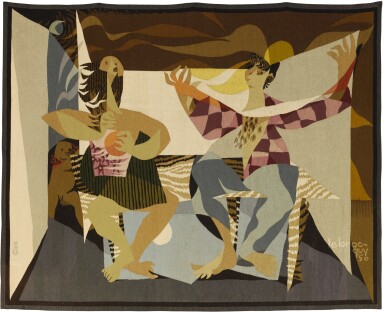
Property from the Collection of Sir Michael Smurfit
LOUIS LE BROCQUY, H.R.H.A. | ALLEGORY
Auction Closed
September 9, 02:37 PM GMT
Estimate
60,000 - 80,000 GBP
Lot Details
Description
Property from the Collection of Sir Michael Smurfit
LOUIS LE BROCQUY, H.R.H.A.
1916-2012
ALLEGORY
inscribed l.r.: le brocquy 50; signed by the artist on the Tabard label attached to the reverse: Louis le Brocquy
tapestry, edition of 9
180 by 225cm., 70½ by 88in.
The Jefferson Smurfit Collection;
Sotheby’s, London, 16 May 2003, lot 113
Limerick, Hunt Museum, Louis le Brocquy: Allegory & Legend, 16 June - 24 September 2006
Agnew's, Louis le Brocquy, Aubusson Tapestries, 2001, exh. cat., illustrated (unpaginated);
Yvonne Scott, Louis le Brocquy Allegory and Legend, Hunt Museum, Limerick, exhibition catalogue, 2006, p.25, illustrated p.71
The tapestries of Louis le Brocquy, which first appeared in 1948, are testament to his prodigious talent and inventive spirit. Within a ten-year period from 1940, when le Brocquy first exhibited, to 1950, the year of the present work, his output reveals an artist constantly seeking stimulation and responding to new challenges. His first paintings from the 1940s show post-Impressionist inspired works, although with a modern edge; then a revelatory encounter with the Travelling communities represented via a Cubist approach (see lot 31) and innovating again with a body of work in a completely new medium – the tapestry.
His introduction to tapestry followed a commission by the Edinburgh Weavers in 1948, which also included artists such as Stanley Spencer and Graham Sutherland. Excited by the medium, le Brocquy engaged with it more fully ‘as a kind of recreation, involving completely different problems; it is refreshing in the sense that one is exhausted in a different way…’ (the artist in interview with Harriet Cooke, published in The Irish Times, 25 May 1973). The works produced reveal le Brocquy’s intuitive ability to translate painterly elements onto the flat ‘insistent surface’ of woven cloth.
Allegory was woven in an edition of 9 by Atelier Tabard Frères and Soeurs in Aubusson, France – a prestigious weavers whose heritage dates to the 17th century. It was the third in a series of seven designed by le Brocquy between 1948 and 1955. As the title infers, the design employs symbols to explore abstract concepts of life, death, time and timelessness, and in doing so looks back to the ancient use of symbols as a visual language. The cycles of nature are inferred by the sun and moon, while ‘there is the additional inference of the fragility of life in the inclusion of the ancient symbol of fate, the unwinding skein of wool’ (Yvonne Scott (intro.), Louis le Brocquy Allegory & Legend, exh. cat., 2006, p.25).
The child that emerges lends an optimistic note but as with much of le Brocquy’s work, particularly of this period, it is also a comment on contemporary affairs. James White wrote that the child represents ‘the lost children of Europe, wandering through a cruel world with wonder and only half-understanding’ (James White, 'Contemporary Irish Artists (VI): Louis le Brocquy', Envoy, vol.2, no.6, Dublin, 6 May 1950, p.59). This ties in with themes within le Brocquy's Traveller series and anticipates the angst-filled works of his Grey period, the sense of isolation evident in A Family (1951, National Gallery of Ireland) being the best-known example.
Le Brocquy was to return to tapestry throughout his career, becoming a significant creative output in parallel with his paintings. One of the artist's earliest examples, Allegory unequivocally demonstrates why his turn to the medium was to play an influential part in the rebirth of tapestry in the 20th century.
